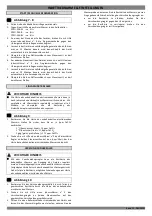
INSTALLATION
ENGLISH - Page 4
PREPARATION
⊷
Illustration 2
For DTSO-200-M:
1.
Connect the two units by means of the provided Y-pieces. The Y-
piece with the conical filter inside, needs to be mounted at the
inlet of the valve or the bottom connection.
2.
First connect both Y-pieces to one unit and afterwards to the
other unit; secure them by means of the 4 clips.
⊷
Illustration 3
3.
Drill a hole with diam. 21 mm (0,83”) in the side wall of the brine
cabinet; the exact position of the hole is not important, as long as
it is approx. 10 cm (4”) below the edge of the brine cabinet; make
sure to remove any drilling debris from the brine cabinet.
4.
Insert the overflow elbow (with gasket) into the hole; at the inside
of the brine cabinet, secure it with the nut.
5.
For DTSO-200-M and DTSO-200-BL: put the control valves and
resin tanks assembly back into the brine cabinet in the correct
position.
INLET - OUTLET
IMPORTANT NOTICE
THE WATER MUST BE FREE FROM SEDIMENT, CHLORINE, IRON
AND MANGANESE! We strongly recommend the installation of
a sediment pre-filter and/or other protective filter(s) upstream
from the device.
THE DYNAMIC WATER PRESSURE AT THE OUTLET OF THE DEVICE
MUST AT LEAST BE 1 BAR (15 PSI) AT ALL TIMES TO ENSURE
PROPER FUNCTIONNING! In case of doubt, we strongly
recommend the installation of our proprietary Delta Pressure
Guard.
We strongly recommend to connect the device to the piping by
means of flexible hoses.
If the device is not installed using the provided bypass valve, we
strongly recommend to install a 3-valve bypass system to isolate
the device from the water distribution network.
The provided bypass valve is not intended to be used as a stand-
alone shut off valve.
Before you start any plumbing work, make sure to shut off the
water supply to the place of installation and to depressurize the
piping.
⊷
Illustration 4
1.
Install the bypass valve, with the green handle pointing upwards,
on the ports of the Y-pieces; make sure the filter screen in the
lower Y-piece stays in place; secure them by means of the clips.
2.
Connect the water supply to the inlet; respect the flow direction,
as marked by means of an arrow ( ).
3.
Connect the internal piping system to the outlet; respect the flow
direction, as marked by means of an arrow ( ).
DRAIN
IMPORTANT NOTICE
Always use the provided grey reinforced flexible hose to connect
the drain of the control valve and the overflow of the brine
cabinet to the sewerage system.
Always use separate hoses for the drain of the control valve and
the overflow of the brine cabinet.
In case of a permanent connection of the hoses to the sewerage
system, an air gap must be provided to prevent any form of
backflow. Use the provided D.O.D. adaptor; make sure it is
installed in a stand pipe that is at least 20 cm long.
To guarantee proper functioning of the device, avoid pinching
and unnecessary kinks and elevations of the drain hoses.
⊷
Illustration 5 - 6
1.
In case a D.O.D. adaptor is used, install it in the stand pipe; it fits
inside a 40 mm pipe or a 40 mm coupling. Ensure a permanent
and watertight connection.
2.
Connect both drain elbows of the Y-drain-set to both control
valves.
3.
Slide one end of a first flexible hose over the Y-piece of the Y-
drain-set; use soapy water as a lubricant; push it on as far as
possible.
4.
Run the other end of the flexible hose to the sewerage system;
shorten it to the proper length. This hose operates under
pressure, so it may be installed higher than the device (max. 2
mtr).
5.
In case a D.O.D. adaptor is used, slide the flexible hose over one
of the two hose barb connections on the D.O.D. adaptor; use
soapy water as a lubricant; push it on as far as possible.
6.
Slide one end of a second flexible hose over the overflow elbow;
use soapy water as a lubricant; push it on as far as possible.
7.
Run the other end of the flexible hose to the sewerage system;
shorten it to the proper length. This hose does NOT operate under
pressure, so it may NOT be installed higher than the device.
8.
In case a D.O.D. adaptor is used, slide the flexible hose over the
other hose barb connection on the D.O.D. adaptor; use soapy
water as a lubricant; push it on as far as possible.
PRESSURIZING
IMPORTANT NOTICE
After the plumbing work, impurities and foreign material may be
left behind inside the piping; we highly recommend to isolate
from the water network (i.e. disconnect or put in bypass) all
water-using devices while rinsing the piping, to prevent these
impurities and foreign materials from entering into these water-
using devices.
1.
Make sure the handle on the bypass valve is in ‘BYPASS’ position;
if necessary rotate the handle clockwise to the ‘BYPASS’ position.
2.
Open the water supply.
3.
Open a cold water faucet downstream of the device and let the
water run until all air is purged and all foreign material is washed
out; close the faucet.
4.
Rotate the handle on the bypass valve counter clockwise to the
‘SERVICE’ position.
5.
Open a cold water faucet downstream of the device and let the
water run until all air is purged; close the faucet.
6.
Check the device and all hydraulic connections for leaks.
Summary of Contents for DTSO-200-B
Page 7: ...Page 7 ENGLISH ...
Page 13: ...Page 13 FRANCAIS ...
Page 19: ...Seite 19 DEUTSCH ...
Page 25: ...Pagina 25 NEDERLANDS ...
Page 26: ......
Page 27: ......





































